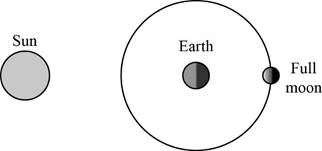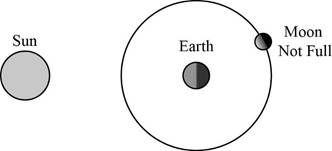
(a)
The fraction of total orbital period of earth through which it move in one period of the moon’s orbit.
(a)
Answer to Problem 6SP
The fraction of total orbital period of earth through which it move in one period of the moon’s orbit is
Explanation of Solution
Given Info: The period of moon’s orbit about the Earth is
The period of orbital motion of Earth is
Write the expression for the fraction of total orbital period of Earth through which it move in one period of the moon’s orbit.
Write the fraction
Conclusion:
Thus, the fraction of total orbital period of earth through which it move in one period of the moon’s orbit is
(b)
The sketch of the sun, the Earth and the moon with the moon in the Full moon condition and also the sketch of the position where the moon would be in
(b)
Answer to Problem 6SP
The sketch of the sun, the Earth and the moon with the moon in the Full moon condition is given in figure 1.and the sketch of the position where the moon would be in
The moon will not be a full moon since the apparent advance of the moon in
Explanation of Solution
When the moon is full, it is on the opposite side of the Earth from the sun. The sketch of the sun, the Earth and the moon with the moon in the Full moon condition is plotted in figure 1.

Figure 1
Write the expression for the angle through which the moon or the Earth advances in one day.
Here,
Substitute
Substitute
Find the apparent advance of the moon relative to sun earth system in one day.
Here,
Find the apparent advance of the moon in
The moon is not full moon yet.
The sketch of the position where the moon would be in

Figure 2
Conclusion:
Thus, the sketch of the sun, the Earth and the moon with the moon in the Full moon condition is plotted in figure 1 and the sketch of the position where the moon would be in
(c)
The extra angle through which the moon have to go to reach the full moon condition and to show it represents approximately an extra two days.
(c)
Answer to Problem 6SP
The extra angle through which the moon has to go to reach the full moon condition is
Explanation of Solution
From part (b), the angle advanced by moon in
Therefore the extra angle that it can have to go to reach the full moon condition is obtained by subtracting apparent angle advanced by moon to total angle.
Find the extra angle for the moon to reach full moon condition.
Here,
Write the expression for the time taken to reach full moon condition.
Here,
Substitute
Conclusion:
Thus, the extra angle through which the moon has to go to reach the full moon is condition
Want to see more full solutions like this?
Chapter 5 Solutions
The Physics of Everyday Phenomena
- Don't use ai to answer I will report you answerarrow_forwardwhy did the expert subtract the force exerted by the hand and the elbow by the force due to the weight of the hand and forearm and force exerted by the tricep. Does the order matter and how do you determine what to put first. Question 4 AP, CHAPTER 13 FROM BASIC BIOMECHANICS 8TH EDITIONarrow_forwardThe drawing illustrates the dispersion of light by a prism. The prism is made from a certain type of glass, and has a cross section shaped like an equilateral triangle. The indices of refraction for the red and violet light in this type of glass are 1.649 and 1.694, respectively. The angle of incidence for both the red and violet light is 60.0°. Find the angles of refraction at which the (a) red and (b) violet rays emerge into the air from the prism. Glass prism Incident light Normal (a) Normal Incident light Red (660 nm) (b) Violet (410 nm)arrow_forward
- Don't use ai to answer I will report you answerarrow_forwardA glass block (n = 1.56) is immersed in a liquid. A ray of light within the glass hits a glass- liquid surface at a 70.0° angle of incidence. Some of the light enters the liquid. What is the smallest possible refractive index for the liquid?arrow_forwardThe drawing shows a crystalline slab (refractive index 1.995) with a rectangular cross section. A ray of light strikes the slab at an incident angle of 01 = 35.0°, enters the slab, and travels to point P. This slab is surrounded by a fluid with a refractive index n. What is the maximum value of n such that total internal reflection occurs at point P? Ме Buarrow_forward
- What is the amount of M112 needed to breach a 5-foot thick dense concrete wall utilizing an internal charge placed in the center of the target?arrow_forwardA small postage stamp is placed in front of a concave mirror (radius = 1.1 m), such that the image distance equals the object distance. (a) What is the object distance? (b) What is the magnification of the mirror (with the proper sign)?arrow_forwardCalculate the anti-clockwise torque and the clockwise torque of the system with the ruler and the washers. Record these values in Data Table 5. Ruler = 11.56 g, small washer = 1.85 g, large washer = 24.30 g. Calculate the % Difference in the Torques and record the values in Data Table 5. Is ΣAnticlockwise torque and Anticlockwise torque the same thing, are they solved in the same way?arrow_forward
- A window washer stands on a uniform plank of mass M = 142 kg and length l = 2.80 m supported by 2 ropes attached at the ends of the plank. The window washer has a mass m = 68.0 kg. What is the tension in each of the ropes, T1 and T2, if the window washer's displacement from the center of mass of the plank is x = 0.930 m as shown in Figure 1: Window Washer Problem?arrow_forwardA man holds a double-sided spherical mirror so that he is looking directly into its convex surface, 33 cm from his face. The magnification of the image of his face is +0.17. What will be the image distance when he reverses the mirror (looking into its concave surface), maintaining the same distance between the mirror and his face? Be sure to include the algebraic sign (+ or -) with your answer.arrow_forwardHow do you draw a diagram of the ruler and mass system in equilibrium identifying the anti-clockwise torque and clockwise torque? How do I calculate the anti-clockwise torque and the clockwise torque of the system with the ruler and the washers, does it come from the data in table 4? Please help, thank you!arrow_forward
 College PhysicsPhysicsISBN:9781305952300Author:Raymond A. Serway, Chris VuillePublisher:Cengage Learning
College PhysicsPhysicsISBN:9781305952300Author:Raymond A. Serway, Chris VuillePublisher:Cengage Learning University Physics (14th Edition)PhysicsISBN:9780133969290Author:Hugh D. Young, Roger A. FreedmanPublisher:PEARSON
University Physics (14th Edition)PhysicsISBN:9780133969290Author:Hugh D. Young, Roger A. FreedmanPublisher:PEARSON Introduction To Quantum MechanicsPhysicsISBN:9781107189638Author:Griffiths, David J., Schroeter, Darrell F.Publisher:Cambridge University Press
Introduction To Quantum MechanicsPhysicsISBN:9781107189638Author:Griffiths, David J., Schroeter, Darrell F.Publisher:Cambridge University Press Physics for Scientists and EngineersPhysicsISBN:9781337553278Author:Raymond A. Serway, John W. JewettPublisher:Cengage Learning
Physics for Scientists and EngineersPhysicsISBN:9781337553278Author:Raymond A. Serway, John W. JewettPublisher:Cengage Learning Lecture- Tutorials for Introductory AstronomyPhysicsISBN:9780321820464Author:Edward E. Prather, Tim P. Slater, Jeff P. Adams, Gina BrissendenPublisher:Addison-Wesley
Lecture- Tutorials for Introductory AstronomyPhysicsISBN:9780321820464Author:Edward E. Prather, Tim P. Slater, Jeff P. Adams, Gina BrissendenPublisher:Addison-Wesley College Physics: A Strategic Approach (4th Editio...PhysicsISBN:9780134609034Author:Randall D. Knight (Professor Emeritus), Brian Jones, Stuart FieldPublisher:PEARSON
College Physics: A Strategic Approach (4th Editio...PhysicsISBN:9780134609034Author:Randall D. Knight (Professor Emeritus), Brian Jones, Stuart FieldPublisher:PEARSON





